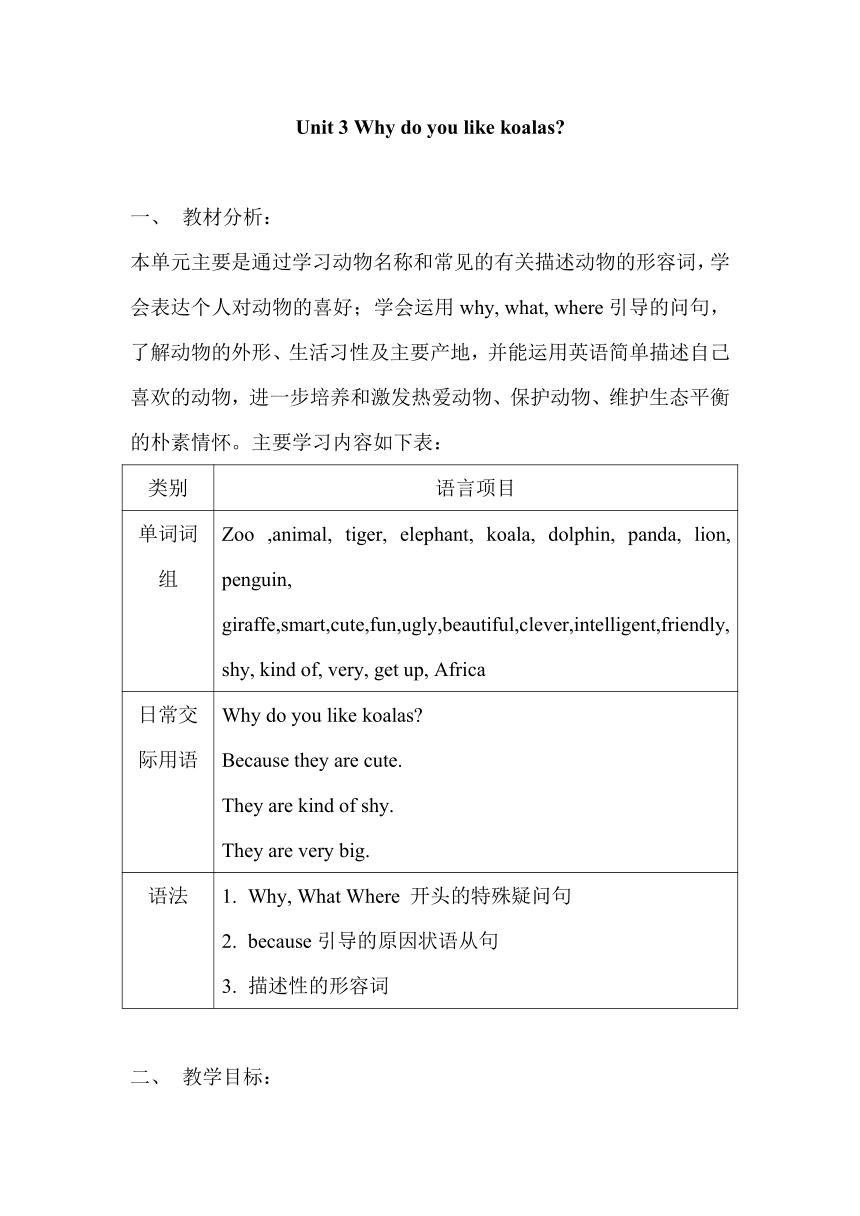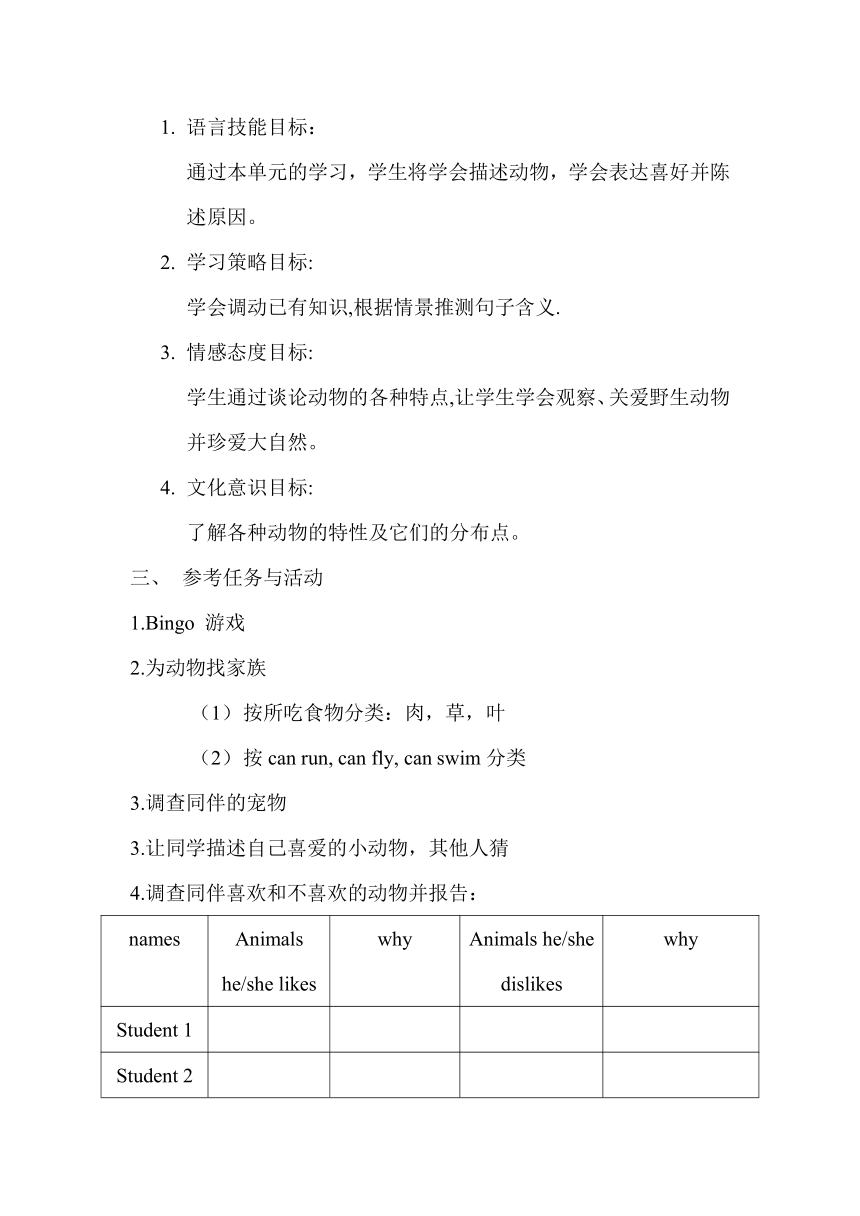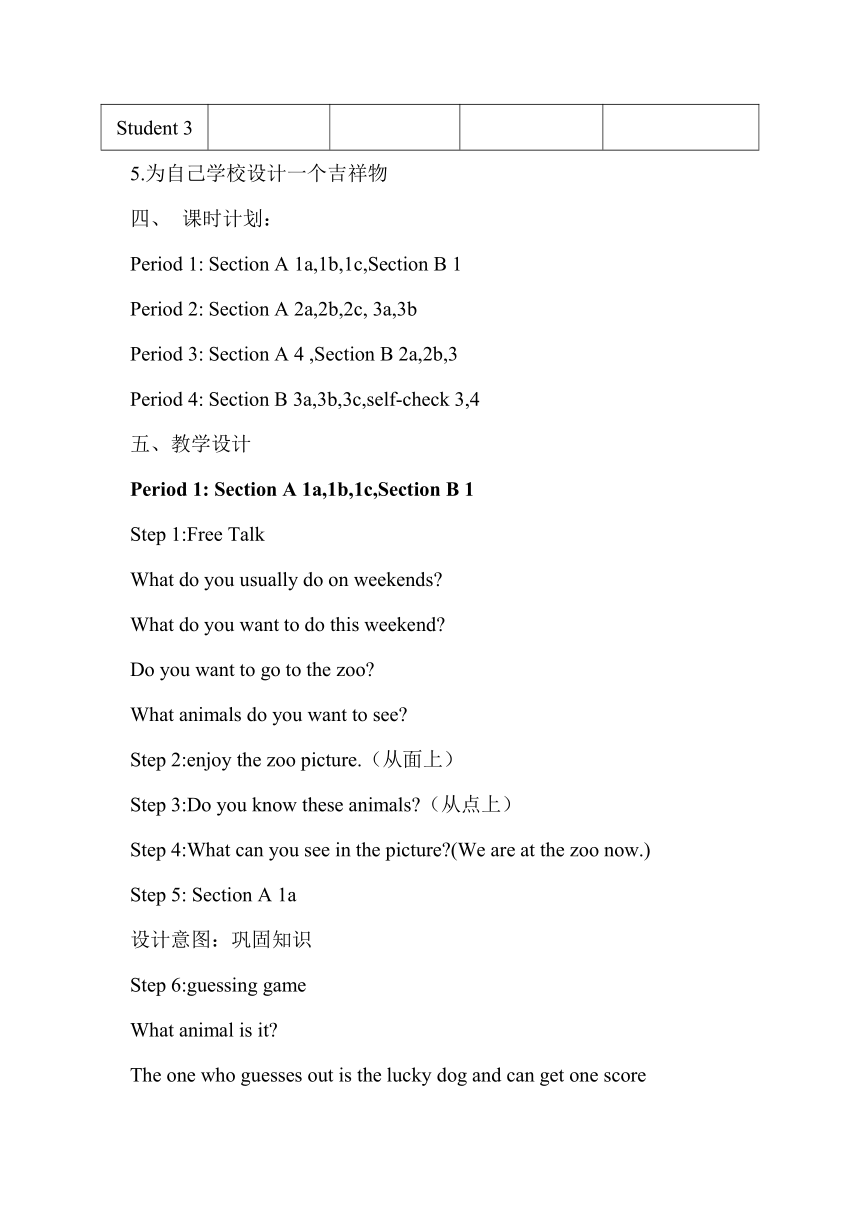Unit 3 Why do you like koalas
文档属性
| 名称 | Unit 3 Why do you like koalas |  | |
| 格式 | zip | ||
| 文件大小 | 16.7KB | ||
| 资源类型 | 教案 | ||
| 版本资源 | 人教新目标(Go for it)版 | ||
| 科目 | 英语 | ||
| 更新时间 | 2012-02-14 16:34:14 | ||
图片预览




文档简介
Unit 3 Why do you like koalas
教材分析:
本单元主要是通过学习动物名称和常见的有关描述动物的形容词,学会表达个人对动物的喜好;学会运用why, what, where引导的问句,了解动物的外形、生活习性及主要产地,并能运用英语简单描述自己喜欢的动物,进一步培养和激发热爱动物、保护动物、维护生态平衡的朴素情怀。主要学习内容如下表:
类别 语言项目
单词词组 Zoo ,animal, tiger, elephant, koala, dolphin, panda, lion, penguin,giraffe,smart,cute,fun,ugly,beautiful,clever,intelligent,friendly,shy, kind of, very, get up, Africa
日常交际用语 Why do you like koalas Because they are cute.They are kind of shy.They are very big.
语法 Why, What Where 开头的特殊疑问句because引导的原因状语从句描述性的形容词
教学目标:
语言技能目标:
通过本单元的学习,学生将学会描述动物,学会表达喜好并陈述原因。
学习策略目标:
学会调动已有知识,根据情景推测句子含义.
情感态度目标:
学生通过谈论动物的各种特点,让学生学会观察、关爱野生动物并珍爱大自然。
文化意识目标:
了解各种动物的特性及它们的分布点。
参考任务与活动
1.Bingo 游戏
2.为动物找家族
按所吃食物分类:肉,草,叶
按can run, can fly, can swim分类
3.调查同伴的宠物
3.让同学描述自己喜爱的小动物,其他人猜
4.调查同伴喜欢和不喜欢的动物并报告:
names Animals he/she likes why Animals he/she dislikes why
Student 1
Student 2
Student 3
5.为自己学校设计一个吉祥物
课时计划:
Period 1: Section A 1a,1b,1c,Section B 1
Period 2: Section A 2a,2b,2c, 3a,3b
Period 3: Section A 4 ,Section B 2a,2b,3
Period 4: Section B 3a,3b,3c,self-check 3,4
五、教学设计
Period 1: Section A 1a,1b,1c,Section B 1
Step 1:Free Talk
What do you usually do on weekends
What do you want to do this weekend
Do you want to go to the zoo
What animals do you want to see
Step 2:enjoy the zoo picture.(从面上)
Step 3:Do you know these animals (从点上)
Step 4:What can you see in the picture (We are at the zoo now.)
Step 5: Section A 1a
设计意图:巩固知识
Step 6:guessing game
What animal is it
The one who guesses out is the lucky dog and can get one score
引出形容词:
small,big,large,interesting,fun,scary,friendly,smart,cute,lazy,ugly,
beautiful, clever, intelligent, lovely, strong, tall, shy
Step 7:listening
Section A 1b
Step 8:Make a dialogue
If you and your friend go to the zoo. What animal do you want to see first Make a dialogue.
A: Let’s see the _____ first.
B: Why do you like ____
A: Because they’re cute/……
B:But I like____. Do you like ___
A:……
设计意图 :在句型操练中巩固知识。
Step 9: Make a survey and give a report:
names Animals he/she likes why Animals he/she dislikes why
Student 1
Student 2
Student 3
设计意图:培养学生的知识综合运用能力。
Step 10: Homework
Make a survey: What’s your best friend’s favorite animal?Why
Period 2: Section A 2a,2b, 2c, 3a,3b
Step 1: Review:
活动形式:就上节课Homework部分Make a report。
Eg:My best friend’s favorite animal is dog.
Because he thinks it’s cute.……
Step 2: challenges(智力大比拼)
1. What animals can swim
What animals eat grass
What animals eat meat
What animals eat leaves
2.old saying:as busy as a bee 忙得团团转
It’s raining cats and dogs.倾盆大雨
Every dog has its day.每个人都有得意的一天。
Step 3: Groupwork:
Ask and answer: What animal is your pet(宠物)
Dolphin.
Why do you like dolphins
Because they are very/kind of(有点) smart.
Report: Why pet is dolphin. Because they are smart.
Step 4 : listening: Action A 2a,2b
2a This activity provides listening practice using the target language.
Call attention to the two blank lines on the left. Ask Ss to listen a recording of a conversation carefully and write the names of the two animals you hear on these lines.
Play the recording the first time.
Listen again and write in the names of the animals.
Check the answers.
2b This activity provides listening and writing practice using the target language.
Call attention to the conversation and the blank lines in it. Ask Ss to listen the recording again, and write a word from the box on each blank line. Some words can be used more than one time.
Ask a student to read the words in the box.
Listen the recording again.
Check the answers.
Step 5 :Where are these animals from
Step 6: Pairwork
Where are lions from
They are from Africa.
Step 7: Homework:
Preview Section B 1
Period 3: Section A 4 ,Section B 2a,2b,3
Step 1: Bingo
Write nine words in the square below .Then listen and cross out the words you hear. Say BINGO when you get a row of Xs.
Step 2:Read the following sentences and find out what animals they are.
(1)It’s only in China .Its color is white and black. It likes to eat bamboo(竹子). Panda
(2)It lives in the cold place—South Pole(南极).It walks like a duck(鸭子). Penguin
(3)It looks like a bear. It can climb the tree(爬树). Koala
(4)It’s big and strong. It can run fast. It’s from Africa. Lion
(5)This animal is very friendly .It can swim fast and play with a ball.
Dolphin
Step 3: listening( Section B 2a,2b)
2a This activity provides listening practice with the target language.
Say, Now I will play a recording of a conversation between Tony and Maria. This time circle the adjectives you bear on the list for la.
Play the recording again. Students circle the adjectives they hear.
Check the answers.
2b This activity provides listening and writing practice using the target language.
Call attention to the three headings. Animal, Maria's Words and Tony's Words, and the write-on lines under each.
Say, Now I will play the recording again. This time please write the name of the animals each person talks about and the words they say.
Play the first four lines of recording and stop the tape. Ask, What animal are they talking about (the elephant) What words does Maria use to describe the elephant (interesting, intelligent)
Point out the write-on lines where students can write these words.
Play the whole recording and have students write the words they hear on the chart.
Check the answers.
Step 4:Pairwork
A: Hello! What animals do you like
B:I like elephants. They’re cute.
A: What other animals do you like
B:I like dogs , too.
A: Why
B: Because they are friendly and clever.
Step 5: Make a survey
Ask your group members their favorite animals and why.
Names
Favorite animal
Why
other animals
Why
Report: My friend’s favorite animal is …
He/She likes them because they’re …
He/She likes …, too. Because they’re …
Step 6:Homework:
Design an animal mascot(吉祥物) for our school.
Period 4: Section B 3a,3b,3c,self-check 3,4
Step 1: enjoy the story 《lion and mouse》 (flash片段)
Step2: Guessing game
What animal do I like
Eg: He is two years old. He is from China. He is black and white. He eats bamboo. He sleeps during the day(白天睡觉).
活动形式:学生叙述自己喜爱的动物信息,让其他同学猜是哪种动物.
Step 3:reading
Section B 3a,3b
Step 4:Show the designs.
活动形式:展示上次课的课后作业,即学校吉祥物。
Step 5:Homework
设计一张卡片,介绍你最的宠物。
六、教学后记:
教材分析:
本单元主要是通过学习动物名称和常见的有关描述动物的形容词,学会表达个人对动物的喜好;学会运用why, what, where引导的问句,了解动物的外形、生活习性及主要产地,并能运用英语简单描述自己喜欢的动物,进一步培养和激发热爱动物、保护动物、维护生态平衡的朴素情怀。主要学习内容如下表:
类别 语言项目
单词词组 Zoo ,animal, tiger, elephant, koala, dolphin, panda, lion, penguin,giraffe,smart,cute,fun,ugly,beautiful,clever,intelligent,friendly,shy, kind of, very, get up, Africa
日常交际用语 Why do you like koalas Because they are cute.They are kind of shy.They are very big.
语法 Why, What Where 开头的特殊疑问句because引导的原因状语从句描述性的形容词
教学目标:
语言技能目标:
通过本单元的学习,学生将学会描述动物,学会表达喜好并陈述原因。
学习策略目标:
学会调动已有知识,根据情景推测句子含义.
情感态度目标:
学生通过谈论动物的各种特点,让学生学会观察、关爱野生动物并珍爱大自然。
文化意识目标:
了解各种动物的特性及它们的分布点。
参考任务与活动
1.Bingo 游戏
2.为动物找家族
按所吃食物分类:肉,草,叶
按can run, can fly, can swim分类
3.调查同伴的宠物
3.让同学描述自己喜爱的小动物,其他人猜
4.调查同伴喜欢和不喜欢的动物并报告:
names Animals he/she likes why Animals he/she dislikes why
Student 1
Student 2
Student 3
5.为自己学校设计一个吉祥物
课时计划:
Period 1: Section A 1a,1b,1c,Section B 1
Period 2: Section A 2a,2b,2c, 3a,3b
Period 3: Section A 4 ,Section B 2a,2b,3
Period 4: Section B 3a,3b,3c,self-check 3,4
五、教学设计
Period 1: Section A 1a,1b,1c,Section B 1
Step 1:Free Talk
What do you usually do on weekends
What do you want to do this weekend
Do you want to go to the zoo
What animals do you want to see
Step 2:enjoy the zoo picture.(从面上)
Step 3:Do you know these animals (从点上)
Step 4:What can you see in the picture (We are at the zoo now.)
Step 5: Section A 1a
设计意图:巩固知识
Step 6:guessing game
What animal is it
The one who guesses out is the lucky dog and can get one score
引出形容词:
small,big,large,interesting,fun,scary,friendly,smart,cute,lazy,ugly,
beautiful, clever, intelligent, lovely, strong, tall, shy
Step 7:listening
Section A 1b
Step 8:Make a dialogue
If you and your friend go to the zoo. What animal do you want to see first Make a dialogue.
A: Let’s see the _____ first.
B: Why do you like ____
A: Because they’re cute/……
B:But I like____. Do you like ___
A:……
设计意图 :在句型操练中巩固知识。
Step 9: Make a survey and give a report:
names Animals he/she likes why Animals he/she dislikes why
Student 1
Student 2
Student 3
设计意图:培养学生的知识综合运用能力。
Step 10: Homework
Make a survey: What’s your best friend’s favorite animal?Why
Period 2: Section A 2a,2b, 2c, 3a,3b
Step 1: Review:
活动形式:就上节课Homework部分Make a report。
Eg:My best friend’s favorite animal is dog.
Because he thinks it’s cute.……
Step 2: challenges(智力大比拼)
1. What animals can swim
What animals eat grass
What animals eat meat
What animals eat leaves
2.old saying:as busy as a bee 忙得团团转
It’s raining cats and dogs.倾盆大雨
Every dog has its day.每个人都有得意的一天。
Step 3: Groupwork:
Ask and answer: What animal is your pet(宠物)
Dolphin.
Why do you like dolphins
Because they are very/kind of(有点) smart.
Report: Why pet is dolphin. Because they are smart.
Step 4 : listening: Action A 2a,2b
2a This activity provides listening practice using the target language.
Call attention to the two blank lines on the left. Ask Ss to listen a recording of a conversation carefully and write the names of the two animals you hear on these lines.
Play the recording the first time.
Listen again and write in the names of the animals.
Check the answers.
2b This activity provides listening and writing practice using the target language.
Call attention to the conversation and the blank lines in it. Ask Ss to listen the recording again, and write a word from the box on each blank line. Some words can be used more than one time.
Ask a student to read the words in the box.
Listen the recording again.
Check the answers.
Step 5 :Where are these animals from
Step 6: Pairwork
Where are lions from
They are from Africa.
Step 7: Homework:
Preview Section B 1
Period 3: Section A 4 ,Section B 2a,2b,3
Step 1: Bingo
Write nine words in the square below .Then listen and cross out the words you hear. Say BINGO when you get a row of Xs.
Step 2:Read the following sentences and find out what animals they are.
(1)It’s only in China .Its color is white and black. It likes to eat bamboo(竹子). Panda
(2)It lives in the cold place—South Pole(南极).It walks like a duck(鸭子). Penguin
(3)It looks like a bear. It can climb the tree(爬树). Koala
(4)It’s big and strong. It can run fast. It’s from Africa. Lion
(5)This animal is very friendly .It can swim fast and play with a ball.
Dolphin
Step 3: listening( Section B 2a,2b)
2a This activity provides listening practice with the target language.
Say, Now I will play a recording of a conversation between Tony and Maria. This time circle the adjectives you bear on the list for la.
Play the recording again. Students circle the adjectives they hear.
Check the answers.
2b This activity provides listening and writing practice using the target language.
Call attention to the three headings. Animal, Maria's Words and Tony's Words, and the write-on lines under each.
Say, Now I will play the recording again. This time please write the name of the animals each person talks about and the words they say.
Play the first four lines of recording and stop the tape. Ask, What animal are they talking about (the elephant) What words does Maria use to describe the elephant (interesting, intelligent)
Point out the write-on lines where students can write these words.
Play the whole recording and have students write the words they hear on the chart.
Check the answers.
Step 4:Pairwork
A: Hello! What animals do you like
B:I like elephants. They’re cute.
A: What other animals do you like
B:I like dogs , too.
A: Why
B: Because they are friendly and clever.
Step 5: Make a survey
Ask your group members their favorite animals and why.
Names
Favorite animal
Why
other animals
Why
Report: My friend’s favorite animal is …
He/She likes them because they’re …
He/She likes …, too. Because they’re …
Step 6:Homework:
Design an animal mascot(吉祥物) for our school.
Period 4: Section B 3a,3b,3c,self-check 3,4
Step 1: enjoy the story 《lion and mouse》 (flash片段)
Step2: Guessing game
What animal do I like
Eg: He is two years old. He is from China. He is black and white. He eats bamboo. He sleeps during the day(白天睡觉).
活动形式:学生叙述自己喜爱的动物信息,让其他同学猜是哪种动物.
Step 3:reading
Section B 3a,3b
Step 4:Show the designs.
活动形式:展示上次课的课后作业,即学校吉祥物。
Step 5:Homework
设计一张卡片,介绍你最的宠物。
六、教学后记:
同课章节目录
- Unit 1 Can you play the guitar?
- Section A
- Section B
- Unit 2 What time do you go to school?
- Section A
- Section B
- Unit 3 How do you get to school?
- Section A
- Section B
- Unit 4 Don't eat in class.
- Section A
- Section B
- Unit 5 Why do you like pandas?
- Section A
- Section B
- Unit 6 I'm watching TV.
- Section A
- Section B
- Review of Units 1-6
- Unit 7 It's raining!
- Section A
- Section B
- Unit 8 Is there a post office near here?
- Section A
- Section B
- Unit 9 What does he look like?
- Section A
- Section B
- Unit 10 I'd like some noodles.
- Section A
- Section B
- Unit 11 How was your school trip?
- Section A
- Section B
- Unit 12 What did you do last weekend?
- Section A
- Section B
